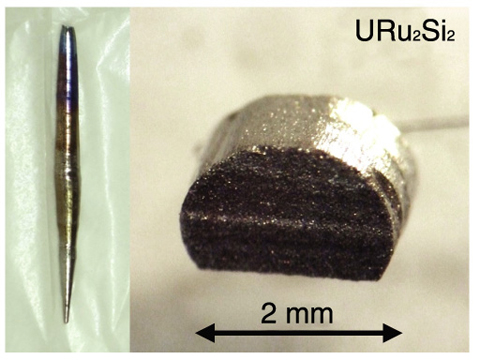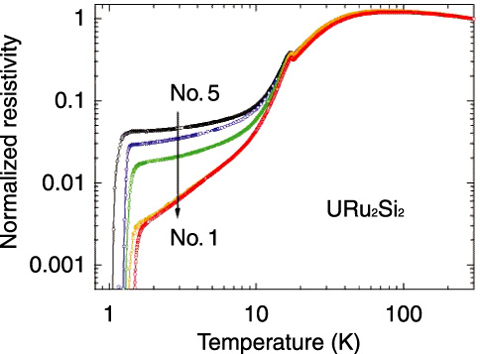
Fig.7-5 Single crystal of URu2Si2

Fig.7-6 Electrical resistivity in the single crystal of URu2Si2
The properties of actinide elements are governed by the behavior of 5f electrons. Because of the degrees of freedom that 5f electrons have, actinide compounds show a variety of ordered states. The well-known examples include the ordering of magnetic moments and the ordering of the electron charge distribution. These conventional orderings have been revealed by microscopic experimental probes such as neutron / X-ray scattering, NMR, and so on. However, the origins of the ordered state of the actinide compound URu2Si2 have not been resolved since its discovery in 1985, despite exhaustive experimental efforts. It is hence described as a “hidden-order” state.
One of the key experiments to tackle this problem would be detailed measurement of the electrical resistivity as a function of temperature (T). Generally, electrical resistivity reflects the electronic state and ordering state through the scattering process. For example, strong electron-electron scattering gives the T2 term of resistivity. However, a high quality single crystal sample is required to avoid large scattering contributions from impurities, dislocations, lattice defects, and so on. Establishing a technique of high quality single crystal growth is a key point for this investigation.
We succeeded in growing a highly purified single crystal of URu2Si2 by a combination of a solid-state electro-transport method for the refinement of the uranium raw metal and a Czochralski-pulling method for growing a single crystal of URu2Si2 (Fig.7-5). Fig.7-6 shows the temperature dependence of the electrical resistivity for 5 pieces that were cut out from that ingot. The residual resistivity of the No.1 sample has the smallest value, which is one-tenth that of No.5. The temperature dependence in the No.1 is different from that of the No.5. Although the No.5 sample has good quality compared to samples reported from other groups in the world, it is still dominated by impurity scattering at low temperatures. On the other hand, in the No.1 sample, the electrical resistivity follows the T1.5. This anomalous behavior cannot be explained by the usual electron-electron scattering process, as mentioned previously. It indicates that the resistivity strongly reflects the electronic state of the “hidden-order” state. These results are unmistakably crucial to clarifying the order parameter in URu2Si2.
Although actinides are very important elements in nuclear science and technology, some diverse characteristics of 5f electrons have not been well-understood, as in URu2Si2. Advances in such research are expected to be connected to understanding the electronic state of actinides.